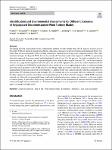Item Infomation
Full metadata record
| DC Field | Value | Language |
|---|---|---|
| dc.contributor.author | Johst, P. | - |
| dc.contributor.author | Kucher, M. | - |
| dc.contributor.author | Bühl, M. | - |
| dc.date.accessioned | 2023-08-25T03:50:15Z | - |
| dc.date.available | 2023-08-25T03:50:15Z | - |
| dc.date.issued | 2023 | - |
| dc.identifier.uri | https://link.springer.com/article/10.1007/s42824-023-00085-7 | - |
| dc.identifier.uri | https://dlib.phenikaa-uni.edu.vn/handle/PNK/8945 | - |
| dc.description | CC-BY | vi |
| dc.description.abstract | The rapidly growing wind industry poses a fundamental problem for wind turbine blade (WTB) disposal in many areas of the world. WTBs are primarily manufactured from composites consisting of a thermoset matrix and reinforcing fibers. Currently, there are no economically viable recycling technologies available for such large-scale composite products. Thus, other treatment strategies for disposed WTBs have to be considered. This study explores the repurpose of WTBs as a promising alternative approach from a processual and technological point of view. For this purpose, the study is guided by the categorization into four different types of repurposed applications: high-loaded complete structure (T1), low-loaded complete structure (T2), high-loaded segmented structure (T3), and low-loaded segmented structure (T4). A three-dimensional CAD model of an Enercon-40/500 (E40) wind turbine blade is derived in a reverse engineering procedure to obtain knowledge about the actual geometry of the WTB. Based on the design, three ecosystems of product scenarios (S) with different manufacturing technologies involved are investigated: a climbing tower (S1), a playground (S2) and the combination of a photovoltaic (PV)-floating pontoon, and a lounger (S3). | vi |
| dc.language.iso | vi | vi |
| dc.publisher | Springer | vi |
| dc.subject | WTB | vi |
| dc.subject | CAD model | vi |
| dc.title | Identification and Environmental Assessments for Different Scenarios of Repurposed Decommissioned Wind Turbine Blades | vi |
| dc.type | Book | vi |
| Appears in Collections | ||
| OER - Khoa học Vật liệu, Ứng dụng | ||
Files in This Item:

